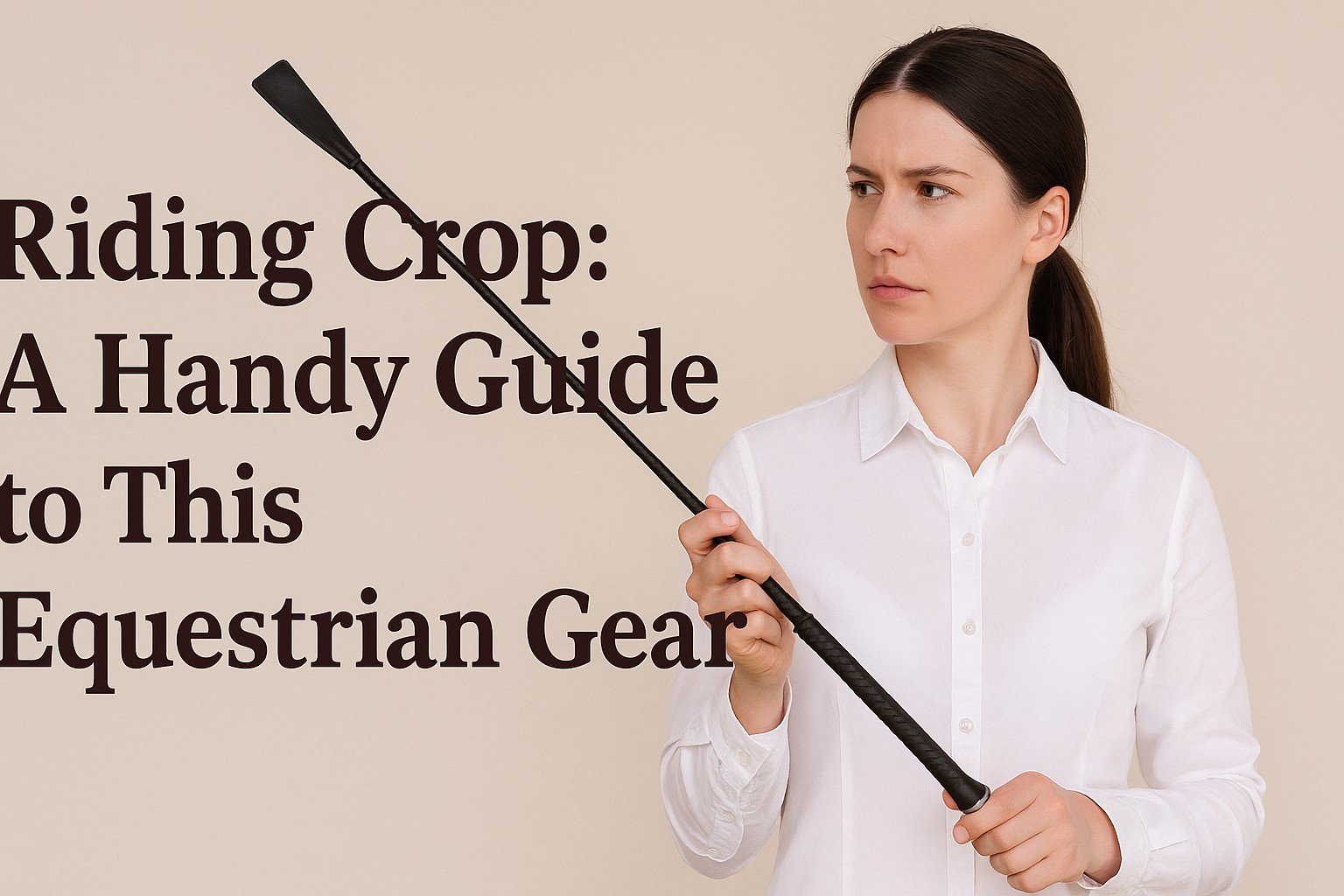A riding crop is a key piece of equestrian equipment, a short, flexible whip used to reinforce a rider’s leg cues. It’s essential in the world of horseback riding equipment, offering clarity and precision, not punishment.
What Is a Riding Crop? (Equestrian Gear Defined)
A riding crop is a short, stiff tool—often around 18–30 inches long—with a firm handle and a leather flap or “popper” at the end. It belongs to the world of equestrian accessories and serves as a subtle extension of the rider’s leg.
Unlike a longer whip, the crop gives close-contact cues—ideal for dressage whip, show jumping, or general riding.
Riding Crop vs. Other Horse Whips
Though “crop” and “whip” are sometimes used interchangeably, they differ:
- A riding crop (or bat) is short and stiff, designed to back up leg aids or gently tap the horse’s shoulder or haunches.
- A dressage whip is longer (up to 43 inches) and lighter, used to reach behind the rider’s leg without letting go of the reins.
- There are also lunging whips, driving whips, hunting whips, each designed for specific tasks.
Anatomy of a Riding Crop (Horse Whip Breakdown)
A modern riding crop typically features:
- A fiberglass or cane shaft, sometimes wrapped in leather or fabric
- A padded grip or mushroom handle to prevent slipping
- A keeper or popper—a short leather tongue at the tip—designed to make light contact without injury
These elements ensure balance, durability, and gentle communication.
Why Use a Riding Crop? (Purpose & Safety in Equestrian Gear)
A riding crop isn’t for punishment—it’s a communication tool. When used properly, it reinforces leg aids, with a gentle tap prompting the horse to move forward, stay engaged, or focus.
In disciplines like jumping or dressage, precise timing can make the difference. A crop fine-tunes cues when leg or voice alone falls short.
How to Use a Riding Crop Correctly (Best Practices)
- Hold it right: Place it across your palm with the button up. Don’t loop it around your wrist to avoid injury if you fall.
- Timing is crucial: Use the crop only after natural aids fail. A light, timely tap behind the leg—connected to seat and voice cues—is most effective.
- Keep it gentle: Never strike hard. Abuse causes physical and emotional trauma, while a soft tap prompts engagement.
- Respect rules: Many competitions limit crop use—length, number of strikes, placement on the body. Always follow discipline-specific regulations.
Choosing the Right Crop (Selecting Horseback Riding Equipment)
Look for:
- The right length: Standard riding crops (~24–30 inches) for general riding; longer for dressage.
- A balanced shaft: Flexible enough for a flick, controlled in movement.
- Comfortable grip: Leather or rubber, sometimes with a wrist loop.
- A soft popper: Gentle enough for safe contact.
Brands and styles vary widely—StateLineTack and Mary’s Tack offer choices for riders across disciplines.
Real Riders on Riding Crops (Community Insight)
On Reddit, riders share real experiences:
I purposefully got a hot pink dressage whip because it’s a lot harder to lose.
Another describes the bat variant:
A ‘bat’ is a form of riding crop with a wider contact end. It’s less painful than a whip and used for encouragement in racing and jumping.
These real-world voices show how design and visibility matter in everyday use.
Conclusion
A riding crop is more than a piece of tack—it’s a bridge between rider intention and horse response. As part of broader horseback riding equipment, used correctly it promotes clarity, not coercion. With the right grip, timing, and respect for rules, a crop enhances performance and strengthens communication. Whether you’re training, competing, or riding for joy, understanding the purpose and safe use of this equestrian accessory is key.
FAQs
1. Is a riding crop cruel to horses?
No—when used correctly, a crop offers light reinforcement. Abuse is harmful, but gentle, well-timed taps promote clarity and trust.
2. What’s the difference between a riding crop and a dressage whip?
A riding crop is shorter and stiffer, ideal for close-contact aid. A dressage whip is longer (up to 43 inches) and reaches behind your leg without letting go of the reins.
3. Can you use a crop in competitions?
Yes, but rules vary. Many disciplines limit length, strikes, and where you can tap. Always check your competition’s rulebook.
4. How do I hold a crop properly?
Let it rest across your palm, button facing up. If there’s a loop, keep it loose. Avoid looping around your wrist to prevent injury during a fall.
5. What should I look for when buying a riding crop?
Choose one with the right length for your discipline, a balanced yet flexible shaft, comfortable grip, and a soft popper end. Quality brands help ensure safety and durability.

